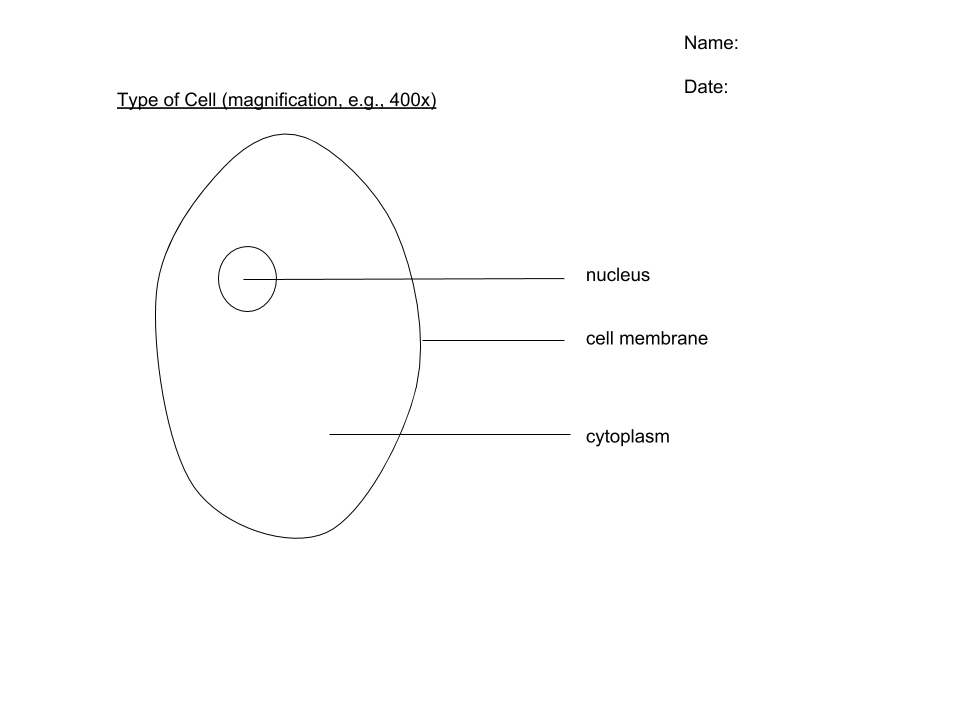Unit 1: My Self
Unit 1, Activity 5: The Small Stuff
MINDS ON
Specialized Cells
So far, we have learned about some of the organ systems that make up our human bodies. We have seen how organs work together to perform important functions inside the digestive, respiratory and circulatory systems.
But did you know that organs are actually made up of smaller groups of specialized cells called tissues? Specialized cells allow for different types of tissues to exist in our organs, so that the organs can perform different functions in our organ systems.
In this activity, we will begin to investigate the "small stuff" of our tissues - cells.
Have you ever heard that cells throughout your entire body are completely replaced every seven years? View the video below to determine if this is actually true. As you watch, pay attention to the many different specialized cells functioning within your own body.
 What Do You Think?
What Do You Think?
- Is it true that your body replaces itself every seven years?
- What types of specialized cells caught your eye or ear?
- What do you think might happen if one type of specialized cells in your body stopped functioning properly?
Structure and Function of Cells

Long Description
Take a look at this image of six different backpacks.
Each of these backpacks has a different structure (including its material, number of straps, number of pockets or capacity) intended for a different specific purpose or function. Though they differ in appearance and function, they are all still backpacks intended to carry things.
For example, the blue backpack with the sleeping bag on it would be suitable for camping, while the green backpack would be a good choice for school. The grey pack with one strap would be perfect for an outing with friends.
This is just like your cells. Each type of specialized cell in your body has a specific structure (what it looks like) and function (what it does) unique from all other types of specialized cells! For example, muscle cells perform special functions which differ from those performed by the cells in your intestine or your blood cells.
Now, let's have a more detailed look into these different specialized cells.
ACTION
Organelles
To understand specialized cells, we need to recall how cells are built and the function of each organelle.(definition:specialized part of a cell) You might remember this from grade 8.
Complete the following interactive to review organelle names and functions. Save it to your Portfolio for future reference.
OrganelleReview
Cells Under The Compound Microscope
Microscopes allow us to see things that are too small for observation by the naked eye. This is important because it allows us to study cells and discover their structure and function, as well as detect disease. This amazing scientific innovation has allowed significant breakthroughs in areas like cancer diagnosis and treatment and increased our understanding of how the food we eat can affect our cells and organs.
How to Use a Microscope
Now that we have reviewed cell structure and function, it is time to look at some real cells under a microscope. The following video demonstrates how a paramecium(definition:a single-celled organism that lives in freshwater) can be located using a compound microscope.
As you may have noticed in the video, it is essential to understand the parts of the microscope before using one. Be sure to follow the steps indicated in the video and in the following tutorial to ensure that you are using a microscope correctly.
MicroscopeTutorial
Biological Drawings
One way that scientists capture images from a microscope is by drawing them. These are called biological drawings and their purpose is to highlight and label important parts of the specimen(definition:the cell you are looking at under the microscope) you are viewing and record its data.
Scientists have set up specific rules when creating these to ensure that all have a similar look and contain the same features.
Take a look at this sample biological drawing:

Rules To Follow
Biological drawings must:
- be done in pencil on blank paper;
- use a ruler to underline title and draw label lines;
- be labelled in a column on the right side of the image;
- have horizontal, parallel lines that do not cross for labels;
- include the magnification of the specimen and type of cell in the title;
- use only stippling(definition:using small dots to show darker areas) rather than colour or shading.
Now, try your own hand at creating biological drawings of specialized cells viewed through the microscope.
Task 1: Compare red blood cells and skeletal muscle cells, which you have learned about in previous activities. Record these similarities and differences.
Task 2: View the cheek cells slide and complete its biological drawing.
MicroscopeLab
 Biological Drawing
Biological Drawing
Refer to the Microscope Lab to complete this assignment by looking at the following slides of specialized cells under the microscope:
- red blood cells;
- muscle cells (skeletal);
- cheek cells.
Use the following organizer to compare these cell types. You will have to research the function of each cell and structure using the internet. You may complete your table in point form.
Research Organizer
| Cell Type | Cell Function (what does this cell do?) | Cell Structure (how do the shape and the organelles in the cell help it perform its function?) | Cell Importance (why is this type of cell important to a healthy body?) |
| Red Blood Cells | |||
| Muscle Cells (skeletal) | |||
| Cheek Cells |
Biological Drawing
- On paper, complete a biological drawing of the cheek cell.
- Remember to follow the rules we learned about earlier in this activity for drawing proper biological diagrams.
- Draw the cell and label the cell organelles that you can see from the image.
- Be sure to draw only the parts of the cell that you can see from the image.
 Self Check
Self Check
When you have finished your research organizer and biological drawing, look it over to make sure your work is complete and that it addresses the Learning Goals.
| Self Check - Research Organizer | |
|---|---|
| I have described the structure, functions and purposes of specialized cells. | |
| I have included clear and accurate information for each of the categories. | |
| I organized my information clearly in a chart. |
| Self Check - Biological Drawing | |
|---|---|
| I have identified the parts of cells using a microscope image. | |
| I have drawn a clear and accurate representation of the cell using the rules of biological drawing. |
CONSOLIDATION
 Super Cells
Super Cells
It's a Bird, It's a Plane, It's...Super Cell!
Now that you have learned about some specialized cells, it is time to design your own Super Cell.

Your Super Cell will be specialized for the human body to help with either the digestive, respiratory or circulatory systems.
You will need to research some specialized cells in these systems to help give you ideas for your Super Cell. To start, you may want to think about some of the issues that these systems could experience, such as indigestion (heartburn), carbon monoxide poisoning or heart disease. The Resources List below is a useful starting point for your internet search.
Your Super Cell might be based on a real cell in our systems, or it could have superpowers that human cells do not have.
Be sure to think both about the structure and function of the cell. What will it look like? What will it do?
Most importantly, think about why this cell would be useful in the body.
 Self Check
Self Check
| Self Check - Super Cells | |
|---|---|
| I have clearly stated the function and structure of my Super Cell. | |
| I have related my Super Cell to the digestive, respiratory or circulatory systems. | |
| I have responded to a classmate's post describing how our Super Cells can work together, based on their structure and function. | |
| I have used appropriate scientific terminology to clearly describe specialized cells. |